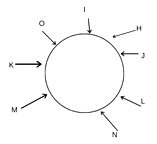Tips and Tricks: Logical Arrangement | General Intelligence and Reasoning for SSC CGL PDF Download
Arrangement Tips and Tricks and Shortcuts
Arrangement problems come in various forms and are categorized into three main types: seating arrangement, linear arrangement, circular arrangement, and rectangular arrangement. Here are tips, tricks, and shortcuts to efficiently solve arrangement questions:

Types of Arrangement
Linear Arrangement:
- Description: The arrangement is linear, forming a single row.
- Tip: Visualize the linear arrangement and note fixed positions if provided.
Double Row Arrangement:
- Description: Two groups are arranged in separate rows, facing each other.
- Tip: Begin with fixed elements and consider interactions between the two rows.
Circular Arrangement:
- Description: Persons are arranged around a circular table.
- Tip: Visualize the circular arrangement and focus on conditions related to positions.
Rectangular Arrangement:
- Description: Similar to circular arrangements, but individuals sit around a rectangular table.
- Tip: Apply circular arrangement principles to a rectangular setting.
Tips for Swiftly Solving Arrangement Questions:
Scan and Identify:
- Tip: Quickly identify key elements and conditions. Highlight or jot down essential information for clarity.
Visualize the Setup:
- Tip: Form a mental map or sketch a rough diagram to aid visualization and understanding of relationships.
Start with Fixed Elements:
- Tip: If certain elements have fixed positions, begin by placing them to establish a foundation.
Apply Elimination:
- Tip: In multiple-choice scenarios, eliminate options that do not align with given conditions.
Work Backwards:
- Tip: Deduce the arrangement by starting from the last step or position and working backward.
Look for Clues and Inferences:
- Tip: Pay attention to hidden clues that may indirectly reveal the position of other elements.
Utilize Constraints:
- Tip: Keep track of constraints and conditions to eliminate impossible placements and refine the arrangement.
Grouping Strategies:
- Tip: Focus on constraints related to groups in arrangements involving clustering.
Avoid Overcomplication:
- Tip: Keep the approach simple and logical, avoiding unnecessary assumptions.
Practice Regularly:
- Tip: Engage in timed practice sessions to improve speed and decision-making under pressure.
Stay Calm and Confident:
- Tip: Approach arrangements with confidence, trusting analytical skills, and applying practiced techniques.
Review and Learn:
- Tip: After solving, review solutions to ensure all conditions are met. Analyze challenges to identify areas for improvement.
By following these tips and tricks, candidates can approach arrangement questions methodically and enhance their ability to solve them efficiently.
Solved Examples:
Q1: Monika is sitting beside Rachel.
Mike is sitting beside Ross, But Ross is not sitting next to Phoebe, who is seated at the extreme corner which is the left-hand side of the bench.
Mike is sitting in the second position from the right of the bench.
Monika is towards the right-hand side of Rachel and Phoebe.
Monika and Mike are sitting together.
Q: In which position is Monika sitting
(a) Between Rachel and Ross
(b) Between Rachel and Mike
(c) Between Phoebe and Ross
(d) Between Mike and Phoebe
Ans: (b)
Phoebe Rachel Monika Mike Ross
As per the above diagram, Monika is sitting in the middle of the bench, between Mike and Rachel.
Therefore option B is the correct one.
Similarly, we shall be asked to arrange a group of people either in a double row or on the basis of directions.
Q2: H, I, J, K, L, M, N, and O are eight friends sitting on a round table such that H is sitting at the second place towards the right of L who is seated between J and N. K is not the neighbor of H. N is sitting next to M.I is not sitting between K and O and o is not sitting between M and K.
Q: Who among the following are the neighbors?
(a) A. H, J
(b) B. I, K
(c) C. M, L
(d) D. K, L
Ans: (a)
As per the above diagram it is clear that H and J are immediate neighbours. Therefore option A is the correct one.
|
177 videos|129 docs|197 tests
|





















